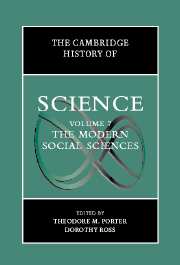Book contents
- Frontmatter
- 1 Introduction: Writing the History of Social Science
- PART I SCIENCES OF THE SOCIAL TO THE LATE NINETEENTH CENTURY
- 2 Genres and Objects of Social Inquiry, From the Enlightenment to 1890
- 3 Social Thought and Natural Science
- 4 Cause, Teleology, and Method
- 5 Utopian Socialism And Social Science
- 6 Social Surveys in the Eighteenth and Nineteenth Centuries
- 7 Scientific Ethnography and Travel, 1750–1850
- 8 History and Historicism
- 9 Bringing the Psyche into Scientific Focus
- 10 Continental Political Economy From the Physiocrats to the Marginal Revolution
- 11 British Economic Theory From Locke To Marshall
- 12 Marx and Marxism
- PART II THE DISCIPLINES IN WESTERN EUROPE AND NORTH AMERICA SINCE ABOUT 1880
- PART III THE INTERNATIONALIZATION OF THE SOCIAL SCIENCES
- PART IV SOCIAL SCIENCE AS DISCOURSE AND PRACTICE IN PUBLIC AND PRIVATE LIFE
- Index
- References
6 - Social Surveys in the Eighteenth and Nineteenth Centuries
from PART I - SCIENCES OF THE SOCIAL TO THE LATE NINETEENTH CENTURY
Published online by Cambridge University Press: 28 March 2008
- Frontmatter
- 1 Introduction: Writing the History of Social Science
- PART I SCIENCES OF THE SOCIAL TO THE LATE NINETEENTH CENTURY
- 2 Genres and Objects of Social Inquiry, From the Enlightenment to 1890
- 3 Social Thought and Natural Science
- 4 Cause, Teleology, and Method
- 5 Utopian Socialism And Social Science
- 6 Social Surveys in the Eighteenth and Nineteenth Centuries
- 7 Scientific Ethnography and Travel, 1750–1850
- 8 History and Historicism
- 9 Bringing the Psyche into Scientific Focus
- 10 Continental Political Economy From the Physiocrats to the Marginal Revolution
- 11 British Economic Theory From Locke To Marshall
- 12 Marx and Marxism
- PART II THE DISCIPLINES IN WESTERN EUROPE AND NORTH AMERICA SINCE ABOUT 1880
- PART III THE INTERNATIONALIZATION OF THE SOCIAL SCIENCES
- PART IV SOCIAL SCIENCE AS DISCOURSE AND PRACTICE IN PUBLIC AND PRIVATE LIFE
- Index
- References
Summary
Jesus Christ was born while Mary and Joseph were on their way to be counted in an imperial census, in order to be taxed. From antiquity onward, the state has played an active part in social survey work. By the sixteenth century, according to the Oxford English Dictionary, the word “survey” meant a state-conducted inventory of property, provisions, or people in order to raise revenue or a military force. However, starting in the seventeenth century, and well entrenched by the nineteenth, a different set of purposes for studying populations had also evolved, and the process of taking surveys began to pass into the hands of other social groups as well. Now voluntary enthusiasts as well as state bureaucrats were becoming concerned with statistics, in the sense not only of facts useful to the state but also of tabulated facts that would depict “the present state of a country,” often “with a view to its future improvement.”
This chapter will explore some key developments and discontinuities in the history of large-scale quantitative social surveys, mainly in Britain and France. Others have told this story in terms of conceptual and methodological discoveries leading toward truly scientific modern surveys. I will instead examine the historical practices of social inquiry considered scientific in their own times, and argue that these investigations were also shaped by social imperatives, even in ostensibly neutral areas like statistical method. The chapter begins with the introduction of the census around the time of the French Revolution, and ends with the move to professionalization around the time of the First World War.
- Type
- Chapter
- Information
- The Cambridge History of Science , pp. 83 - 99Publisher: Cambridge University PressPrint publication year: 2003
References
- 9
- Cited by

